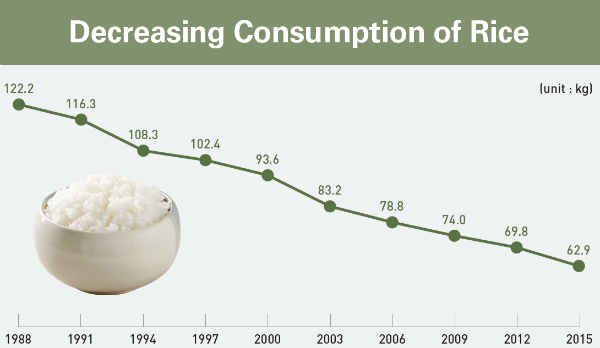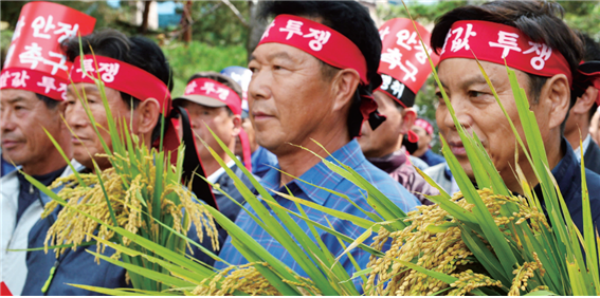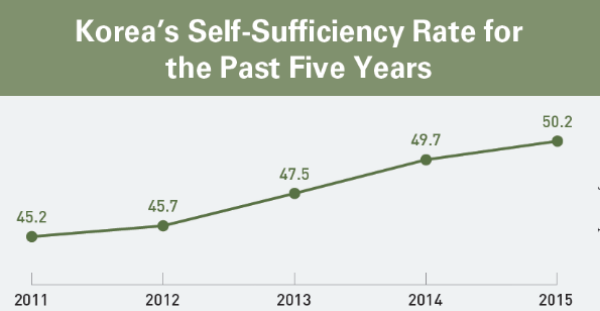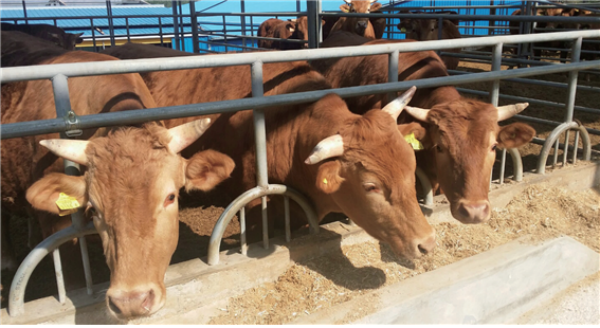An activist farmer, Baek Nam-gi, passed away on September 25. After his death, there have been numerous controversies surrounding his death, and the issue became a hot potato in the Korean political scene. While the public discusses more about his death, there are only a few discussing why farmer Baek had joined the protest last November. Mr. Baek joined the protest as he wanted the government to manage the dropping prices of rice. At present, the prices of rice are dropping quickly, because while rice consumption is decreasing rapidly, the production is going in the opposite direction and rising. This led Korean farmers to face a deficit. To resolve the situation, the government has announced that the absolute farmland (land that can only be used for farming) can be open for other purposes. Despite the intentions, this announcement faced repercussions from different areas of society. The Sungkyun Times (SKT) analyzes the current situation, and possible alternatives different from the announced policy.
“Absolute Farmland” in Korea
In Korea, the term “absolute farmland,” also called “agricultural development region,” means that the land specified as absolute farmland can only be used for farming and other farming-necessary purposes, such as stash. At present, about 1.036 million hectares (ha) of land are dedicated to be used as farmland in Korea, which accounts to more than 17 times the size of Seoul. Once the land is selected as an absolute farmland, its usage usually does not change.
Unlike the previous years, the government has started to release some absolute farmlands so that the land can be used for other purposes. The government mainly focused on unregistering absolute farmlands that are small or divided due to the expansion of railroads or highways. In 2016, the government has unregistered 85,000 ha of absolute farmland, and is planning to release 15,000 ha more by the early next year. The government further plans to mitigate the conditions necessary to unregister the absolute farmland.
Intentions Behind the Decision
• Protecting the Prices of Rice
The government has decided to reduce the absolute farmland to control rice supply and price. The price of 80 kg of rice decreased by about 20% due to overproduction, now averaging 138,555 (based on the data collected from September 15). This price is similar to the price of 80 kg of rice in 1996, which was in 136,713 average. Considering the inflation over the past 20 years, the value of rice has dropped significantly.
The prices of rice are dropping because the demand for rice is decreasing, while the production is increasing. According to sources, intake of rice has decreased by nearly a half over 27 years from 122.2 kg per year to 62.9 kg per year, while the production of rice increased over the past few years. The majority of Korean people are stepping away from rice due to several reasons. Normal eating habits of Korean people has become more westernized than before, and their diet no longer includes as much rice as the ordinary Korean meal. Another reason is that there are those who have realized that the ordinary Korean meal has excessive carbohydrates, which can lead to obesity, hyperglycemia, and diabetes.

The leftover rice is then stored by the government, after the government buys the leftover rice at a maximum of 85% of the original price. The government currently stores about 1.75 million tons of rice, which is 420 thousand tons more than last year. The stored amount is also two times more than the preferred rice storage advised by the Food and Agriculture Organization of the United Nations (FAO), which is 800 thousand tons.
• Reducing Expenditures
As there is more leftover rice, the prices for storing have increased, too. It has been reported that the government spends 500 billion every year just on storing rice. Including all the other expenditures that the government is spending on the rice industry, such as preserving the loss of farmers and transportation of rice to storages, the government has been paying around 3.2 trillion annually.
What is worse is that the expenditures required are expected to increase continuously. In this year, it is expected that 4.15 million tons of rice would be produced, and this amount is 550 thousand tons more than the needed amount of rice.
• Lack of Methods to Use Rice
There are many different methods that can be used to deal with the leftover rice in storages, but there has not been a clear resolution. Donating rice to North Korea is a possibility, but considering the current relationship between North and South Korea, it is unlikely to happen. There had been other suggestions such as giving aids to poorer countries, but sending aids costs more than storing rice. According to the Korea Rural Economic Institute (KREI), sending rice aids to foreign countries costs 240 billion. This is eight times more expensive than storing 100 thousand tons of rice, which is 31.6 million. For the reasons listed above, the government is planning to reduce the absolute farmland so that there would be less rice produced.
Reasons for Opposition
There had been opposition to government’s decision to reduce absolute farmland. They point out that this decision will only bring short-term results, causing loss in the long run. Many farmers, especially those in the rural parts of Korea, are opposing this decision because they are worried that they might lose their farmland. There are also other stakeholders opposing the decision.

Future Food Security
Even though South Korea has an excessive self-sufficiency rate of rice, which is 101%, the rate of other crops is very low. As a result, South Korea is a nation with the lowest crop self-sufficiency rate among OECD states (23.8% in 2015). With very low crop self-sufficiency rate, South Korea spends ten billion dollars every year on importing other crops, such as wheat, and beans.

Having such a low crop self-sufficiency rate renders the nation’s food security vulnerable, and if the production of rice decreases, as the government plans to do, Korea would have an even lower self-sufficiency rate of crops. Korea might have to depend on other nations for food. Korea has already experienced occasions in which it had to import crops at extreme prices. In 1980 and 1993, Korea imported rice at high prices due to famines. Recently, in 2010, Korea had to buy wheat at extreme prices because the nations exporting wheat had decided not to export.
Already having experienced these crop inefficiency situations, cutting down absolute farmland would lead to lesser food production, which would then lead to the weakening of the future food security. The government planned to increase its self-sufficiency rate of crops to 32% by 2020 in 2011, but the current momentum the government is taking is going in opposite direction.
Environmental Damages and Unplanned Development
It has been known that farmlands, especially rice paddies, play an important role in the environment. Rice paddies help control floods, prevent soil loss, assist circulation of atmospheric gas during summer, and serve as locations where migratory birds take a rest on their journey. If absolute farmland is removed, then there would be massive an ecological loss.
Furthermore, Meng Ji Yeon, a Director of Policies at the Korean Federation for Environmental Movements, has argued that most of the absolute farmland are paddies that preserve water, and are the basis of ecosystems for surrounding mountains and streams. Referring to the new town projects, she further added that most of those projects have removed mountains and paddies, building factories and apartments in their place. If the land is no longer
an absolute farmland, the same situation would happen, causing whole ecosystems to change. Since it is impossible for the land to become farmland again, once factories and apartments are built over it, the environmental impacts would be fatal.
Prepare for Unification
According to FAO, North Korea lacks about 660 thousand tons of rice. This is quite an opposite situation from the South in which there is too much rice. Since the unification could happen at any day, it has been pointed out that the South should prepare as much rice as possible to help the North Koreans. One of the primary goals of the unified Korea would most likely be supplying enough food resources to the North and South, which have a total population of 76 million. Considering the reported economic situation of the North, it is quite unlikely that it has enough food resources to support the total population. If the absolute farmland continues to shrink, the South cannot assure that it would have enough food resources to support the unified population.
Possible Alternatives
The original plan of the government was to increase the farmland to solidify the future food security of Korea. The announced plan to reduce the absolute farmland on the other hand is a plan that goes against to the government’s original intention. If the leftover rice and over-production are the problems, there are also possible alternatives, other than reducing the size of farmlands.
Stockbreeding Industry
One of the other possible uses of leftover rice is to use them for feeding livestock in the stockbreeding industry. At present, only rice that had been stored for more than two years can be used for livestock. It is possible to reduce this time period to let the rice be used as feed. The stockbreeding industry in Korea currently imports most of the fodders from foreign countries. If using the overly produced rice to feed the livestock animals is possible, Korean stockbreeding industry can be independent from foreign fodders. Furthermore, since there would be more rice being consumed, the demand for rice would increase, helping the stabilization of prices of rice. There had already been talks to use about 60,000 ha of absolute farmland to harvest rice for feeding livestock animals.

Rice Production Control System
The Rice Production Control System was a policy adopted and practiced from 2003 to 2005. This policy allowed the farmland not to harvest rice, and keep the land uncultivated for a year. For those who adopted this policy, the government supplied three million won of subsidy per hectare. The policy did not have the opportunity to restart in 2007, and was abolished in 2008. The Rice Production Control System could not restart because the government believed it had failed to reduce rice production. This does not mean that the policy was a failure, because at the time, South Korea aided the North with rice, meaning the overly-stored rice had a usage. The general supply of rice was stable after giving aids. Now, as the relationship with North Korea has deteriorated, using the control system once more would be one of the most practical policies.
The Rice Production Control System can be the answer to the current crop situation in Korea. As mentioned before, South Korea only has rice with enough self-sufficiency rate while the other crops have very low rate of self-sufficiency. At present, 99% of wheat, 95% of corn, and 70 - 80% of barley and beans are all imported, which cost $100 million every year. This rate is minimal compared to that of other nations. Countries like the United States, Canada, and Germany have self-sufficiency rates of crops of nearly 100%.
By using the Rice Production Control System, the government could encourage the farmers to use the farmland to plant other crops like wheat, beans, or barley. One of the primary reasons to why the farmers have not raised crops other than rice is that the government is giving minimal subsidies to farmers who grow crops other than rice. At present, the average consumption of wheat has been increasing continuously, now reaching 32.2 kg per year, which is half of the consumption of rice. Since the eating habits of Korean people has changed, the farming industry should change as well.
Production of rice is currently going in the opposite direction from the normal economic cycle: The production is increasing though the demand is decreasing. Changes should be made, but the adjustments should be as passive as possible since food production is vital for the future of Korea. At present, the self-sufficiency rate of rice in Korea is over 100%, while the same rate for other crops is hitting rock-bottom. The farming industry in Korea should move towards a balance of self-sufficient rates of food not only to decrease the amount of rice, but also to ensure the security of food in the future, and possibly for the unification.
